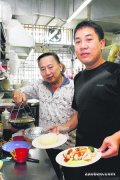Yunnan coffee planting tide
The Pu'er Coffee Development Association is located in the city's Tea Bureau building, whose roof is designed to be the leaves of one of the most common crops in Pu'er. There are few government offices in China that pour visitors a cup of coffee like that-although Liu Bo, the deputy director, was working hard to promote the tea industry a year ago.
In 2007, the city in southern Yunnan Province changed its name to the historic city of Pu'er, and changed it to Simao when the Communist Party was liberated, in order to bring more market effect to the city's rich Pu'er tea. Now the identity of Pu'er City has changed a lot. In 2008, farmers here suffered huge losses due to the bursting of the price bubble of Pu'er tea, which was probably caused by speculation by government officials and futures speculators. Now with the encouragement of the local government, they have begun to invest heavily in the coffee industry. Some growers have developed lush hillsides into land for growing coffee beans, which used to grow tea. Pu'er now has 28000 hectares (70000 acres) of land for coffee cultivation, twice as much as in 2009 and is expected to grow by another 50 per cent by 2015. (by contrast, the city has 220000 hectares of land to grow all kinds of tea, about the same amount as it did three years ago.)
The economic motivation is obvious. Families who grow one hectare of coffee earn more than $10000 a year, three times as much as the tea industry and more than five times as much as corn or rice, Mr. Liu said. Since the late 1980s, Nestl é, together with the Chinese government and the United Nations Development Program, has started a coffee planting program in Pu'er. The earliest coffee growers in Yunnan were missionaries from Europe in the 10th century. They found that the climate there was suitable for growing coffee, but the local people did not like it. Now almost all the coffee in China comes from Yunnan. After Nestl é, other companies also began to purchase coffee from Yunnan, which is in short supply. Coffee beans are sold at international prices, with the highest price reaching 40 yuan ($6.30) per kilogram last year and now 30 yuan per kilogram. The price three years ago was 16 yuan per kilogram.
There are also some coffee beans of poor quality. The high price of coffee beans last year led farmers to mix shoddy goods with high-quality coffee beans. Last year, a local exporter named Liu Minghui returned a large batch of coffee beans-after all, he wanted to protect a big brand: Starbucks, the global coffee chain, which buys most of the beans from Liu. In 2010, Howard Schultz, president of Starbucks, visited Pu'er. Mr. Liu said in his coffee office that it was the first time a foreigner came to Pu'er on a private plane. Soon they will be looking for a small town called Starbucks.
China Coffee Trading Network |: www.gafei.com
Important Notice :
前街咖啡 FrontStreet Coffee has moved to new addredd:
FrontStreet Coffee Address: 315,Donghua East Road,GuangZhou
Tel:020 38364473
- Prev

Coffee shop stall: make a chicken rice by heart
There is a delicious Hainanese Chicken Rice stall in the 408 coffee shops on 10 roads of Hongmaoqiao. Stall owner Yan Shijin has been running Hainanese Chicken Rice stalls for more than 30 years, and he can do everything himself. Because of his insistence, there is always a queue of people in front of Hainan chicken stalls in rural areas.
- Next

Nestle Gold Coffee bears witness to quality of life
At present, the 'Nestle Gold' coffee products sold in the Chinese market are produced in Japan, selected from world-famous coffee beans, carefully baked and extracted with advanced technology, and are known as the top grade of instant coffee.
Related
- Why are the coffee in some coffee shops not enough after being frozen? What should I make up for my American latte cappuccino coffee after being frozen?
- How much water does it take to steam coffee by hand? Why is the coffee brewing and steaming time 30 seconds? What is the purpose of steaming coffee?
- The suspected drink contains too much caffeine! Overlord Tea Lady responds urgently!
- Starbucks rejects antique paper coupons?! Netizen: Missed marketing opportunities!
- What ratio of water temperature and ground does the smart cup method use to press coffee? The difference between brewed coffee and filtered coffee?
- What is the standard process for the purpose of coffee cup testing? What is the difference between hand-brewed coffee and cup testing?
- How to use hand-brewed coffee paragon small golden balls? How does cold coffee lock in the aroma of coffee?
- Is American coffee black? What is the difference between American coffee and drip coffee?
- Unexpected! Well-known tea beverage brand Lele Tea will withdraw from the Zhengzhou market!
- Starbucks enters the fashion and beauty industry?! Netizen: Give me an ice American eye cream

